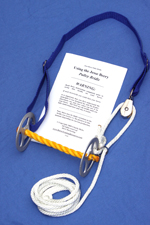Is Your Horse Like A Thick-Skinned Hippopotamus?
Here’s Andy Curry with another great message:
One of my favorite programs on TV is 60 minutes.
But one time, a journalist named Mike
Wallace got himself in a pickle.
He was interviewing the Soviet President Boris Yeltsin.
Wallace asked the former president if
he was “thin-skinned” about the press.
But the translator mis-translated the
question.
When Yeltsin heard the question, it
was translated to him as:
“Is Boris Yeltsin a
thick-skinned Hippopotamus?”
Yeltsin responded by saying that Wallace should express
himself in a more civilized manner.
Funny how things can get mis-communicated.
And when it comes to horses, it happens all the time.
Think about it.
Your horse doesn’t know what you mean
when you ask him to do something unless he’s done
it enough to know what you want.
When you first ask a horse to do something, he’s more
or less “guessing” what you want.
He’s actually searching for a way out
of the pressure you’re putting on him.
And when the pressure’s off he kind of
goes “whew!” and realizes when you do “X” then he’s
supposed to do “Y”.
The wrong thing to do would be to quit
the pressure when he’s not doing what you want.
That would teach him to do something you didn’t ask.
You’d be surprised how often that happens.
An example is riding a horse and you ask him to go left.
But he goes right.
If you let him when you were asking him go left, then you
just taught him to either do what he wants and/or to go
right when you want to go left.
Thus, you might ask yourself if you’re having trouble
getting your horse to do something.
Is it because you’re not “translating” it correctly?
But that’s not the whole picture.
There’s also the part that it takes
about 30 days for a horse to learn a verbal cue.
So just because a horse just learned what “trot” meant
doesn’t mean that from here on out he’s going to trot
when you say trot.
It has to be reinforced constantly.
Not reinforcing it is not translating to his language.
One of the best ways you can translate to your horse is
to have a good foundation on him.
The foundation starts from day one of
any horse’s training.
In fact, most trainers I know will fix
a horse problem by starting them over as if they
didn’t know anything.
Why?
Because they need to see what he knows
and what he doesn’t.
And what he doesn’t know will have to
be taught to the horse.
Or, maybe he learned the wrong thing due to a mis-translation.
Thus, if your horse has behavioral problems and you can’t
seem to fix it, then I would urge you to restart him and
go through the motions and fix it.
Diana Quintana has a great 30 Day program she puts her
horses through and I would encourage you to follow it.
Here’s a for instance from her program.
When you work a horse in the round pen
and you’re getting him going from one gait to the next,
it should be smooth.
Not just “JERK!” into the next gait.
No.
It should be more of a smooth transition.
That means from going slow to going faster and from going
fast and going back down to slower.
A horse needs to know he can go from fast to slower and do
so without being excited and out of sorts.
You must “translate” to him that that’s what he must do.
As I said, Diana’s system is tried, tested, and very thorough.
To see more about it, click on the following:
Get Your Diana Quitana Training DVD
Remember.
A horse may not be doing something right because it’s what
he understood to be right.
Boris Yeltsin understood Mike Wallace said he was a
thick-skinned Hippopotamus.
But that’s not what Wallace said.
It got lost in translation.
Is your horse not doing something right because it
gets lost in translation?
Get Your Diana Quitana Training DVD
Ok.. enough for today. Stay safe with your horses!
Charlie
P.S. I’ve made the 10% coupon active for anyone for this week.
Simply use the coupon code:
CHARLIEHORSE
on the final checkout page and you’ll get 10% off anything
you put in the shopping
cart.
Lord bless,
Charlie


